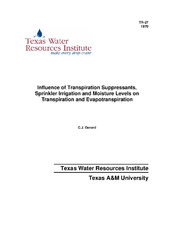| dc.description.abstract | In 1968 and 1969, moisture level treatments were applied to tomatoes and citrus. Light sprinkler applications and white acrylic paint were applied to leaf canopies of tomatoes and citrus. Moisture use and yields as influenced by treatments were determined. Microclimatic data as influenced by treatments were determined. Estimates of influences of treatments on transpiration were evaluated with thermoelectric sensors. Tomato and citrus plant parts were analyzed for certain chemical properties. Diurnal changes in citrus tree trunks and fruits were monitored with linear variable displacement transducers.
Moisture Use and Yield
The effects of treatments on tomatoes were influenced by years. In 1968, the effects of treatments on water use were small and inconclusive. The white reflective treatment reduced water use by tomatoes by 10%, but reduced yields by 30% in 1969. Evaporative cooling increased yields of tomatoes in 1968 and 1969.
Water use by citrus was significantly increased by sprinkler treatment in 1968, but not in 1969. In 1968, evaporative cooling increased total citrus yields and increased the tonnage of fruits which could be sold to fresh market. Evaporative cooling was effective in influencing fruit quality and size, and offers the promises of increasing the yield of quality produce and of making more efficient use of our diminishing water supply.
Microclimatic Data
Canopy, leaf and soil temperatures, humidity, and net radiation data for tomatoes and citrus indicated that evaporative cooling and reflective treatment modified plant stress conditions in canopies of tomatoes and citrus. However, the differences due to treatments on tomatoes were small in 1968, and the differences on citrus were small in 1968 and 1969. Climatic conditions in canopy and net radiation data indicated that reflective treatment on tomatoes was effective in reflecting the incoming solar radiation in 1969.
Thermoelectric Data
Sap flow as influenced by treatments and climatic conditions was evaluated with a thermoelectric method. Sap flow was highest by tomatoes grown on the sprinkler treatment, and least by tomatoes grown on the dry treatment. Moisture contents of tomato stems were influenced by time and treatments.
Sap flow in citrus as influenced by treatments and time was illdefined, possibly due to open structure of citrus. One-of the greatest problems with the use of the thermoelectric method for evaluating sap flow for tomatoes and citrus in the field was plant variability.
Chemical Analyses
Evaporative cooling and reflective treatments increased the Ca content and lowered the K:Ca ratio of tomato fruits. Previous research has shown that these chemical properties are associated with lower plant water stress. The lower Ca content of citrus leaves and lower Brix¡ and acid content of grapefruits indicate that citrus treated with sprinkler applications was under lower plant-water stress than citrus on the control treatment. Sprinkler applications increased the C1 concentration of leaves causing moderate to severe defoliation in 1968 and 1969. Defoliation may have confounded the potential results or trends.
Plant-Water Stress
Diurnal changes in citrus tree trunks and fruits were effectively monitored by linear variable displacement transducers (LVDT). These data suggest that the diurnal changes in tree trunks and fruits were indices of plant-water stress. Sprinkler treatment reduced daily fruit shrinkage and enhanced fruit enlargement in 1969. | en |


